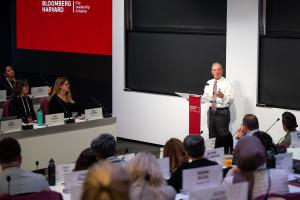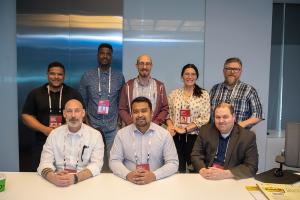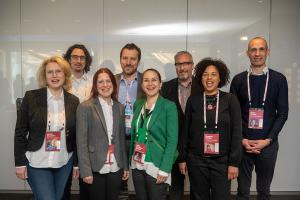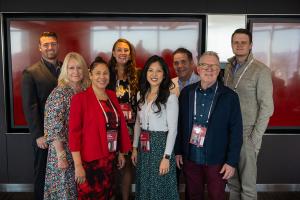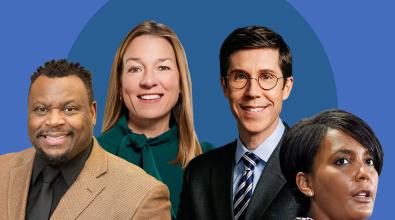Building collaboration muscles for next-level problem solving
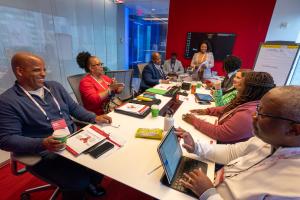
At the Bloomberg Harvard City Leadership Initiative's Cross-Boundary Collaboration Program, city teams of eight civic leaders from in and out of local government learn how to build effective partnerships to solve community problems.
It was not the kind of offer that comes along every day. And Eric Genrich, the mayor of Green Bay, Wis., knew it.
A big local employer, the JBS meatpacking plant, offered to give the city 26 acres of land, as well as seed funding to help develop it. Genrich saw a golden opportunity for his growing city of 107,000. Not only could Green Bay essentially build a new neighborhood from scratch. It also could tackle some of its biggest problems, such as a shortage of affordable housing and green space, while stitching a marginalized neighborhood near the plant into the fabric of the city.
But Genrich also recognized the deep challenges inherent in complex projects like this. Engaging the community to build a common vision for change is never easy. Success would require active partnerships with players from the public, private, and nonprofit sectors. There also was a tight deadline, thanks to the terms of a $5 million state grant, to spend the money by 2025. “As a community, we always want collaboration on big projects,” Genrich says. “But that’s easier said than done.”
As all this came together, Genrich jumped at another big opportunity: participating in world-class executive education program for mayors through the Bloomberg Harvard City Leadership Initiative. And, as part of that year-long offering, he was able to hand pick a team of eight civic leaders to do deep-dive work aimed at building collaboration capabilities across sectors and boundaries.
Green Bay’s “team of eight” came from both inside and outside City Hall, including members from city and county government, JBS, philanthropy, and a housing nonprofit. Together with teams from other cities, they heard from Mike Bloomberg how he leveraged collaboration as Mayor of New York City, and drilled into Harvard principles of “teaming” across organizations, overcoming barriers to collaboration, and building partnerships that generate public value for the community. Following a week of kick-off sessions last April, they returned home eager to engage more partners, listen to residents, attend virtual classes, and put classroom learnings to work.
Today, Genrich says the team is already helping drive the kind of ambitious results he wants to see from the JBS redevelopment.
“Cities can’t tackle big challenges on their own, whether it’s housing and homelessness or drug addiction and the fentanyl crisis—these are community-wide challenges,” he says. “What Green Bay residents want to see, and what the residents of any community want to see, is their elected and community leaders coming together, setting egos aside, and just tackling issues that people are faced with.”
[Read: Bloomberg Philanthropies CEO Patti Harris shares tips on collaboration]
Last week, 77 civic leaders from 10 cities around the world were in New York for the latest edition of Bloomberg Harvard’s Cross-Boundary Collaboration Program. Each team is working on a complex problem—including issues like blight, homelessness, or economic recovery—that can't be solved without effective partnerships. As Bloomberg Philanthropies CEO Patricia E. Harris puts it: "The truth is that the most successful and sustainable solutions demand the buy-in, brainpower, and resources of stakeholders across a city."
As this year’s teams learn how to strengthen their collaboration muscles, Bloomberg Cities spotlights how last year’s teams are already putting these lessons to work.
Designing a new neighborhood in Green Bay
For Green Bay’s collaboration team of eight, the first benefit of the Bloomberg Harvard program was simply having several days together at the outset to focus. As Amaad Rivera-Wagner, Genrich’s chief of staff, explains: “In a world where we’re often managing crises while also trying to plan years into the future, it was an absolutely wonderful experience that allowed very busy people to create time and space.”
Their mission was to devise an inclusive planning process for the JBS project, one that centers equity and includes community voices who aren’t typically heard at planning meetings. At the same time, they needed that process to move quickly to meet tight deadlines.
When the team returned to Green Bay, they tapped into an even larger group of about 45 stakeholders representing community groups, schools, businesses, and other local institutions, which resulted in an open call for urban planning firms to lead project design. Next month, the winning firm will unveil three design concepts and solicit community feedback before presenting a final design.
[Read: 'Teaming' in and out of City Hall]
Rivera says the process so far is striking a balance to be both inclusive and decisive—and is emerging as a collaborative participation model the city would like to use for future development projects. People representing nearby neighborhoods, schools, and other groups have a strong voice in the overall vision without getting bogged down in design details. “Residents tell us they want a walkable neighborhood but they get frustrated if they have to be involved in designing every curb,” Rivera says. “The process can’t be forever iterative.”
Now other stakeholders engaged in the planning are stepping forward with offers to bring services to the neighborhood once it’s built. There’s talk of a health center, business incubator, and commercial kitchen, among other amenities. “Another thing we learned from the Bloomberg Harvard collaboration program is that it’s not enough to just build this neighborhood,” Rivera says. “We also have to give it purpose.”
Listening to residents in Mannheim
For the team from Mannheim, Germany, one of the biggest lessons learned from Bloomberg Harvard was to truly understand the problem they were trying to solve.
Mannheim came to the program thinking that the problem was climate-change impacts in a dense neighborhood of immigrants. Their team, made up of city administrators and neighborhood leaders, hoped to work with residents to reduce summer heat by greening a small public plaza.
But when the team asked residents about how they would change the plaza, they expressed a very different set of concerns. The seating was uncomfortable. Traffic on a street through the space was dangerous. And kids would play soccer in a playground area, making it difficult for other users of the space to enjoy themselves. Nobody was talking about climate change.
So the Mannheim team pivoted toward a new focus: empowering the neighborhood’s residents to help solve their own problems. “This shift was part of the Bloomberg Harvard process,” says Peter Drakul, chief of staff to Mayor Peter Kurz. “We learned to listen more to the people.”
At a gathering in July, neighbors and plaza users workshopped solutions that the city has been rolling out ever since. Comfortable park benches have been installed. Kids painted colorful murals on the walls bordering the area. Next, the street will be closed to traffic. “For residents, their first need was not to combat climate change, it was to just have a calm space,” says Liane Schmitt, Mannheim’s head of human resources and a member of the collaboration team. “It was a great opportunity to build trust between residents and the city’s administration.”
Scottsdale, Ariz., tackles homelessness
When Scottsdale Mayor David Ortega created a team of eight to take on the problem of homelessness, the intensive week of in-person sessions was the first time the group, which included four city staff and representatives from the regional planning agency, an affordable housing developer, and homeless advocacy and service providers, came together. .
“One lesson we learned is that teams gel under intense pressure,” explains Assistant City Manager and group member Brent Stockwell. “The Cross-Boundary Collaboration Program takes that team, puts them into an environment with people from around the world, and then pressurizes them to quickly identify the problem you’re working on, the root causes, and possible entry points for solutions.”
One member of the Scottsdale team came with a keen understanding of the lived experiences of homeless residents from interviews and research she’s conducted. Her insight that longtime residents of Scottsdale were among those experiencing homelessness—not just transient people passing through—gained influence and contributed to a decision to use hotel rooms as temporary housing, Stockwell says.
[Read: How to collaborate through a crisis]
Another lesson from Scottsdale’s experience is that collaboration is a skill worth investing in. After the weeklong session in New York, Scottsdale sent two staff members to the Harvard Kennedy School for an executive education program focused on implementing public policy. One of them is now leveraging that experience to build a collaboration with local high schools and colleges to build the talent pipeline of students who want to work in local government.
“We so appreciated the problem-driven iterative adaptation methods we were taught at Bloomberg Harvard that we invested about $25,000 to increase our capacity to not only do this one time but build it into other things we do as well,” Stockwell says. “It’s about sustaining this beyond the collaboration program to keep it going.”
